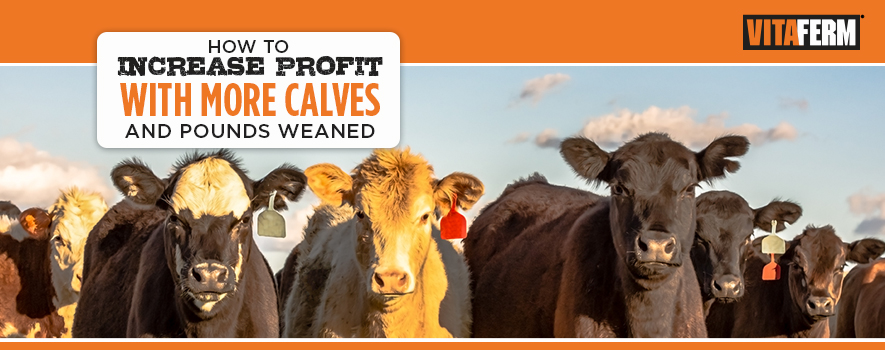
It isn’t every calving season that a producer gets 100-percent calf crop, and accomplishes that in just one month. But this fall, brothers Carter and Locke St. John at Dry Creek Farm in Pell City, Ala., did just that. During breeding season, 31 of their 33 cows were successfully bred, and then all 31 of their cows calved in the 31-day period. They know the value of getting live calves on the ground and doing so in a short calving season.
“I mean 45 days is good, but 31 days is even better,” Locke said, about their successful, short breeding window. “We don’t like to drag it out much.”
Locke gives credit to VitaFerm® Concept•Aid® for his successful conception and calving rates. This is the third year that Dry Creek Farm used Concept•Aid, and as a result saw more cows get bred and stay bred, resulting in more calves for them to market. The registered Hereford operation uses Embryo Transfer and A.I., extensively, and noticed an increase in embryo production in their donors when they first used Concept•Aid. Then they decided to use it on the entire cow herd.
“Now we see substantially better conception rates, unheard of where we are, in both our A.I. and E.T. programs,” Locke said. He is especially proud of their conception rates from last winter that resulted in a successful calf crop this fall, as they were faced with the challenge of drought, and limited feed resources as hay was hard to come by in the South.
At Dry Creek Farm, the cows are supplemented with Concept•Aid 5/S 60 days pre-calving to 60 days post-breeding, which typically gets them to the end of March or early April each year. Then, they switch to the VitaFerm HEAT® IGR (transitioned to VitaFerm® HEAT® with ClariFly®), which helps with fly control – an added stress reliever for the cows during gestation.
All VitaFerm products contain Amaferm®, is a prebiotic designed to enhance digestibility by amplifying the nutrient supply for maximum performance. It is research-proven to increase intake, digestion and absorption. In addition to the Amaferm advantage, Concept•Aid offers proteinated trace minerals (Copper, Zinc, and Manganese), that play a critical role in reproduction. These are the most stable, bioavailable organic trace minerals on the market. Concept•Aid is also high in Vitamin E, an antioxidant that plays an essential role for general cell wall integrity and muscle repair, and assists in quicker breed back post-calving.
The calving rate success the St. John brothers experienced this fall is parallel with the results from a Concept•Aid Reproductive Success Study conducted this summer where data was collected from 16 registered and commercial herds. Breeding, pregnancy, calving and weaning data were collected from ranches across the United States utilizing Concept•Aid products in their breeding operation and compared to industry averages previously reported by external researchers. The study showed that those herds on Concept•Aid had an average calving percentage of 93.6 while the national average is 87.8%. The St. Johns had a conception rate of 93.9%, with a 100% calving rate.
“Amaferm helps them digest and absorb the nutrients better that they are already getting, and helps with intake,” said Dr. Lynsey Whitacre, Business Development and Field Support for BioZyme® Inc., who analyzed the data. “The idea behind Concept•Aid is to provide really high-quality vitamins and minerals used in breeding, so it helps supplement whatever they are getting from the pasture or whatever their feed source is.”
Perhaps the most significant data in the study showed that Concept•Aid doesn’t only aid in getting cows bred, and keeping them bred, but more pounds of calf were weaned from the cows who were fed Concept•Aid. Cows that were fed Concept•Aid, weaned a calf that weighed, on average, 590 pounds, compared to the national average of just 531 pounds, a difference of 59 pounds per calf.
Locke confirms that he saw similar results from his 2016 calf crop he weaned earlier this year. He said that group of calves weighed between 50-75 pounds more a piece at weaning, coming off the cows that had been fed Concept•Aid.
“With weaning weight, we saw quite heavier calves coming off our Concept•Aid cattle. Not only did feeding Concept•Aid help with the pregnancy, but it also helped the animal maintain itself through the lactation period and helped the calf also,” Dr. Whitacre said. “We wanted to show the positive effects Concept•Aid has on breeding and calving rates as well as the lasting impact it has on the calf, and the weaning weight data helped us understand that a little bit better. Hopefully our customers will see the rewards they are getting for using a premier product like Concept•Aid.”
The combination of increased conception and calving rates along with higher weaning weights ultimately returns more dollars of profit to the producer. For instance, for every 100 cows in a herd, Concept•Aid adds an advantage of $13,369 on calves alone ($133.69 per cow), not including improved animal health and reduced supplemental feed costs.
The Amaferm advantage found in Concept•Aid helped Dry Creek Farm shorten their calving window and get more calves on the ground in 2017, leading to a more consistent calf crop. Their 2016 calves weaned heavier, with the potential to get more return on their investment. To learn more how Concept•Aid can increase your reproductivity, visit https://vitaferm.com/reproductive-success-report.


